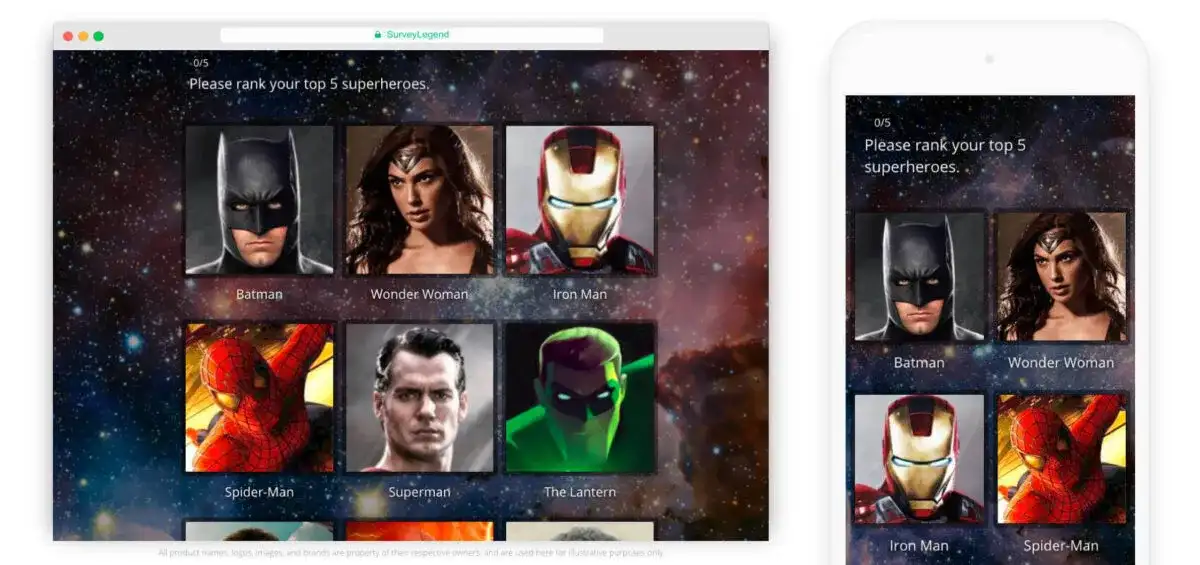Systematic sampling is a probability sampling method that selects participants at fixed intervals from a larger population after choosing a random starting point. It’s simple, efficient, and cost-effective, making it popular for large, well-organized populations. The process involves defining the population, assigning numbers, choosing a sample size, calculating the sampling interval, selecting a random start, and then picking every nth member. Benefits include ease of use, low bias, and evenly distributed samples. Drawbacks occur when population patterns match the interval or when the population size is unknown. Using online surveys, especially with images, can further improve engagement and response rates.
Create your FREE Survey, Poll, or Questionnaire now!
Systematic Sampling Definition
Systematic sampling is defined as “a type of probability sampling method in which sample members from a larger population are selected according to a random starting point but with a fixed, periodic interval.” The first step is to define the population and establish a sampling frame from which the sample will be drawn. We call this interval the sampling interval. Systematic sampling ensures equal probability for each member of the population.
Systematic sampling requires knowledge of the population size to determine the appropriate sampling interval. Systematic samples are created by selecting individuals at regular intervals from the sampling frame, ensuring each has a known and equal probability of selection.
It’s worth noting that, along with the “classic” systematic random sampling above, there is also linear systematic sampling, in which a skip pattern is created following a linear path rather than using a sampling interval, and circular systematic sampling, in which the sample starts again at the same point after ending. For this blog, however, we will continue to focus on systematic random sampling.
Create your FREE Survey, Poll, or Questionnaire now!
How Systematic Sampling Works
Systematic sampling is a probability sampling method that streamlines the process of selecting a representative sample from a large population. Instead of randomly picking individuals one by one, systematic sampling uses a random starting point and a fixed sampling interval to efficiently select sample members from a population list.
Here’s how systematic sampling works in practice: First, you define your entire population and determine your desired sample size. To calculate the sampling interval, simply divide the population size by the sample size. For example, if your population size is 1,000 and your desired sample size is 100, your sampling interval would be 10. Next, you use a random number generator to select a random starting point within the first interval (for instance, any number between 1 and 10). From that starting point, you select every 10th member of the population list until you reach your target sample size.
Create your FREE Survey, Poll, or Questionnaire now!
Example of Systematic Sampling
Want to see this sampling method in action? Here is a look at the six systematic sampling steps with a real-world example.
1. Identify Your Population. This is the group from which you are sampling.
You are a small business owner with 2,000 customers. This is your population size.
2. Assign Numbers to the Population. In this step, you give every member of the population a number.
You put your customer list into a spreadsheet and number them from 1 to 2,000.
Create your FREE Survey, Poll, or Questionnaire now!
3. Determine Your Sample Size. Sample size is how many people from the total population you will survey.
Because you don’t have the time or money to survey all 2,000 customers, you choose to survey 10% of them, or 200. This is your sample size.
4. Determine Your Sampling Interval. To do this, divide the population size by the desired sample size. This sampling interval is a predetermined interval (or fixed interval) used for evenly spaced sampling.
In our example, 2,000 / 200 = 10. This means you would survey every tenth person from your total population of 2,000, using a fixed interval of 10.
5. Choose an Initial Starting Point. To ensure the sampling is random, choose a number between 0 and your sampling interval.
You can select a number between 0 and 10, and choose 7. This is your initial starting point.
Create your FREE Survey, Poll, or Questionnaire now!
6. Identify Sample Members. Now that you have your sampling interval and initial starting point, you can get started! This process results in a random group of individuals selected at the predetermined interval.
Selection begins at 7, and then every tenth person is selected from there (7, 17, 27, 37, and so on). For this reason, systematic sampling may also be referred to as systematic random sampling, as it uses evenly spaced sampling at fixed intervals to create a representative random group.
Systematic Sampling Advantages and Disadvantages
When evaluating different sampling methods, it’s important to consider the advantages of systematic sampling. Systematic sampling is popular with researchers because it is easy to conduct, efficient, and less likely to introduce survey bias into the sample. Systematic sampling ensures that each member of the population has an equal chance of being selected, which helps produce representative samples. This allows researchers to draw conclusions about the entire population with greater confidence.
Create your FREE Survey, Poll, or Questionnaire now!
Of course, there are also a few drawbacks. The disadvantages of systematic sampling include its dependency on population size and sensitivity to patterns or sequences within the population, which can introduce bias. Additionally, the limitations of systematic sampling arise when the sampling list has a cyclical pattern that aligns with the sampling interval, potentially leading to unrepresentative samples or biased results. Compared to other sampling methods, systematic sampling is most effective in large, well-structured populations, but may not be suitable for populations with irregular or unknown structures.
Five Pros of Systematic Sampling
Systematic sampling can be used whenever you want the benefits of randomly sampling the population you’re studying. It can be especially useful in situations where you don’t have details of the entire population before you begin your study. This is because systematic sampling is rule-based, so you can just apply the interval you’ve chosen to the data.
1. Ease to Use and Understand
First and foremost, systematic sampling is quite simple to conduct, making it a favorite for researchers. Plus, this method’s central assumption – that the results represent the majority of normal populations – helps to guarantee that the entire population is evenly sampled.
Create your FREE Survey, Poll, or Questionnaire now!
2. Quick and Cost-Effective Sampling Interval
The way systematic sampling is structured makes surveys easy to create and the data easy to analyze. This type of sampling is also effective when the budget is right because the sample selection process is relatively straightforward with no further research needed at the outset.
3. Semi-Controllable Selection Process
Although systematic sampling is random, with researchers having to select a sampling interval and starting point, it’s not “excessively random” like simple random sampling, another method of sampling which is conducted completely by chance, for example, literally choosing names from a hat.
Create your FREE Survey, Poll, or Questionnaire now!
4. Low Risk of Data Contamination
With systematic sampling, the risk of data contamination is inherently low because of the even distribution of members to form samples. Plus, the only random component of the sample is the selection of the starting point. From there on, the process moves in a set pattern until the sample is complete. However, if there is a chance that the researchers can manipulate the interval length to arrive at a desired conclusion, choosing a simple random sampling technique would be the better option, as systematic sampling can be vulnerable to data manipulation if not carefully controlled.
5. Low Risk of Bias
Because the selection process is random, there is little chance of sampling or survey bias – with some exceptions, for example, when the sample has some sort of repeating pattern. Let’s say you’re looking at a classroom list of students with “boy, girl, boy, girl” ordering. If the sampling interval is two, the sample may introduce gender bias, greatly skewing survey results. Systematic sampling can introduce bias if the sampling interval aligns with a cyclical pattern or systematic patterns in the population, as this alignment may cause certain groups to be over- or under-represented in the sample.
Create your FREE Survey, Poll, or Questionnaire now!
One Drawback of Systematic Sampling
One main disadvantage of the systematic sampling approach is the need to know the size of the population. Additionally, the accuracy of the systematic sampling process depends on having a representative sampling frame—a complete and unbiased list or database from which samples are drawn. Without this information, or if the sampling frame is not representative, this technique has flaws, and the limitations of the systematic sampling process become apparent. The good news is that systematic sampling still works if you are ready to guess the interval.
For example, a film company wants to survey theatergoers about a new movie. Although they don’t know how many people will attend the screening in advance, they can choose to survey every fifth person leaving the theater. Then, the true population size will be approximately five times the size of the sample.
Create your FREE Survey, Poll, or Questionnaire now!
Systematic Sampling with Online Image Surveys
As with any survey, to improve your response rates to avoid having to find a new systematic sample, consider using online surveys with photos. Systematic sampling can enhance the efficiency and representativeness of data collection in online surveys by ensuring a more structured and unbiased selection of respondents. With SurveyLegend, our picture surveys boost engagement, help trigger respondent emotion and memory, and cross language barriers.
Below is an example of one of our photo surveys, designed to match the small business survey/sampling scenario we highlighted earlier. You can also create polls with pictures, questionnaires with images, and much more.

Create your FREE Survey, Poll, or Questionnaire now!
Conclusion
Systematic sampling, or systematic random sampling, is a quick, easy, and effective way to survey smaller subsets of a large population at random and without introducing survey bias. Other methods, such as cluster sampling, involve dividing the population into groups (clusters) and then selecting a random subset of these clusters before sampling individuals within them, which can be especially useful when a complete list of the population is hard to obtain. Whether you go with this type of sampling or another technique, we’ve got you! SurveyLegend lets you start for free and has dozens of beautiful and responsive online survey templates from which to choose.
Do you use systematic sampling when conducting surveys? Is there another method of sampling you prefer, and if so, why? Let us know in the comments! Systematic sampling helps researchers draw conclusions about larger populations efficiently.
Create your FREE Survey, Poll, or Questionnaire now!
Frequently Asked Questions (FAQs)
What is systematic sampling?
Also known as systematic random sampling, this is a type of probability sampling method in which a subset of a larger population is selected according to a random starting point but with a fixed, periodic interval.
Why should you use systematic sampling?
This sampling method is generally easy and inexpensive. The risk of data contamination and sampling bias is also low compared to other sampling techniques.
How many types of systematic sampling are there?
There are three main types: systematic random sampling (the most popular), linear systematic sampling, and circular systematic sampling.



